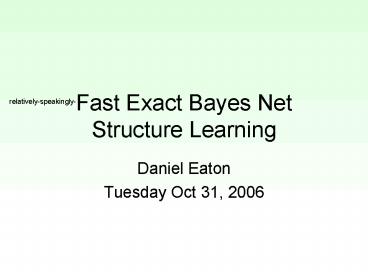Fast Exact Bayes Net Structure Learning - PowerPoint PPT Presentation
1 / 22
Title:
Fast Exact Bayes Net Structure Learning
Description:
alpha. We assumed alpha was easy to compute. for each i, there are 2N values ai ... Compute Alphas. For each node, compute af,i(:) and a1,i(:) (1x2N vectors) ... – PowerPoint PPT presentation
Number of Views:42
Avg rating:3.0/5.0
Title: Fast Exact Bayes Net Structure Learning
1
Fast Exact Bayes NetStructure Learning
relatively-speakingly-
- Daniel Eaton
- Tuesday Oct 31, 2006
2
What structure learning is
- (SL)
Data
A
B
optimize
Space of models
) .1
p(
A
B
integrate
p(
) .2
A
B
) .7
p(
A
B
eg. dirichlet-multinomial DAGs
3
What SL is for this talk
- Have complete exchangeable data
- M cases, N variables
- Continuous or discrete
- Model space DAGs with CPD for each node (ex.
multinomial or linear gaussian) - plus a prior on parameters p(?G), and DAGs p(G)
4
What SL is for this talk
- To determine posterior over DAGs given data
- For each DAG G
- compute marginal likelihood p(dataG) by
integrating out parameters ? - easy for conjugate prior models
- ie. dirichlet-multinomial
- p(Gdata) a p(dataG)p(G)
- Unfortunately ...
5
Why SL is hard
- Number of DAGs is superexponential in of nodes
- 7 node DAGs...
- Even with a tight graph representation (1 b/edge)
takes 6.3 GB to store - Posterior prob takes 8.2 GB
6
Possible resolutions
- RW MCMC on DAG space
- "Posterior landscape" too big and bumpy bad
mixing, doesn't work for Ngt10 - Never represent DAGs Condition on node orderings
(Buntine 1991) - Compute marginal probability of "graph features"
- Friedman Koller 2003 -gt MCMC
- Koivisto Sood 2004 -gt Exact!
7
Graph features
- Just an indicator function on DAGs (f(G)) which
is 1 iff a particular structure (ie. an edge)
exists in the graph, 0 otherwise - Assume N3, want to know marginal probability
that edge from A -gt B exists - Of course, naively, this sum is difficult for ngt5
...
A
B
A
B
A
B
fab(
) 1
fab(
) 0
fab(
) 1
C
C
C
8
Conditioning on orders (order-trick)
- Order on variables, just a permutation of index
set - ie. 3 node graph, (1,2,3), (2,1,3), (3,2,1), ...
- Only N! of these!
- For a fixed order
- Intuition Can consider each node independently
of the others (acyclicity ensured by ordering)
9
Order-trick feature probability
- Ultimately we want to determine
- For now, assume order known so we go for
- know how to do denominator
- numerator depends on feature f
- for f a single edge (A-gtB), it's easy
10
How to use order-trick in practice
- Except in very special (perhaps bio) cases we
don't know the node order a priori - Must sum over N! orders
- Ouch, still super-exponential!
- 1. Sample orders with MCMC (Koller/Friedman)
- Sampler mixes much better than in DAG-space
- Order-space smaller and less bumpy
- 2. Do it exactly with dynamic programming!
- Koivisto Sood (2004)
11
Koivisto
- Recognize that although there are N! orders to
sum over, there is much redundant computation - Will allow us to compute the marginal probability
of a particular feature in O(N2N N2N-1C(M)) time - All edge marg probs in O(N32N) time (naive)
- Or, O(N2N) time with a recent (2006) extension
that I won't cover today
12
Koivisto
- Consider
- just need a way to evaluate
- since
- can be computed by setting f 1
13
- To simplify derivation, assume uniform
- Please accept that (proof later, if requested)
- so that
- Introduce
- so that
key each term is modular
14
- Brute force
()
O(NN!)
(1)
(2)
(3)
ordered sets
(1,2)
(1,3)
(2,1)
(2,3)
(3,1)
(3,2)
(1,2,3)
(1,3,2)
(2,1,3)
(2,3,1)
(3,1,2)
(3,2,1)
a1()a2(1)a3(1,2)
a2()a1(2)a3(1,2)
E
DP recurrence ...
a3(1,2) x ( a1()a2(1) a2()a1(2) )
15
- DP
O(N2N)
2
3
1
unordered sets
1,3
2,3
1,2
1,2,3
16
alpha
naive O(N3N)
- We assumed alpha was easy to compute
- for each i, there are 2N values ai()
- "Möbius transform"
- Exists clever algorithm to compute each ai in
O(2N) time (so O(N2N) overall) - Intuition (2 node)
precompute
3 node
111
11
10
11
10
11
101
010
110
10
100
00
01
00
01
010
00
01
001
000
17
Koivisto summary
- For each nodes, for each possible parent set,
compute ML(i,Gi), fi, p(Gi) (each Nx2N arrays) - Compute Betas
- ßf ML . f . p(G)
- ß1 ML . p(G) (trivial feature f1, used for
normalization) - Compute Alphas
- For each node, compute af,i() and a1,i() (1x2N
vectors) - Compute gf(V) using af and g1(V) using a1
O(N2N-1C(m))
O(N2N)
O(N2N)
O(N2N)
O(N2N N2N-1C(m))
18
Timing
30s
30m
day
19
Order-trick limitations
- Graph structure prior must be modular
- Breaks markov equivalence
- Cannot have arbitrary priors (ie. uniform
impossible) - Cannot query arbitrary features (f must be
modular) - ie. Directed path between nodes A B
- Resolution use MCMC with proposal based on
sampling from marginal edge probabilities - An independence sampler
- Works well for N5
20
Improvement by MCMC
"cancer" network
21
Improvement by MCMC
22
Follow-up
- To read Exact Bayesian structure learning from
uncertain interventions - Kevin Daniel
- Submitted to AIStats06
- To run
- Code in CVS Aline/koivisto
- Probably best to wait till Dec to use
Happy Halloween































